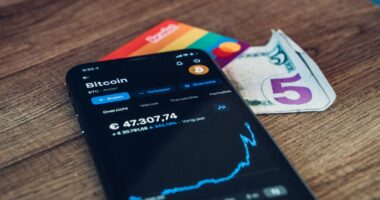NFTs, or non-fungible tokens, have significantly impacted the art world in recent years, transforming the processes of buying, selling, and owning digital art. Unlike fungible cryptocurrencies such as Bitcoin or Ethereum, NFTs are unique digital assets that represent ownership or authenticity of specific digital artworks or collectibles. This uniqueness contributes to their value and desirability in the art market.
Digital art encompasses various forms of artistic expression created using digital technology, including digital paintings, illustrations, animations, and virtual reality experiences. The emergence of NFTs has provided digital artists with a novel method to monetize their work and engage with a global audience of collectors and art enthusiasts. By tokenizing their digital art as NFTs, artists can create scarcity and exclusivity while ensuring the provenance and authenticity of their work through blockchain technology.
NFTs have become a significant development for digital artists, offering a new avenue to monetize and showcase their work in a decentralized and secure manner. Understanding the potential of NFTs and digital art is essential for artists seeking to participate in the NFT marketplace and capitalize on this emerging sector of the art world.
Key Takeaways
- NFTs are unique digital assets that represent ownership of a specific item or piece of digital content, such as art, music, videos, and more.
- When choosing a platform for NFT creation, consider factors such as fees, user interface, community support, and security features.
- When creating and uploading your digital artwork for NFTs, ensure that the file is in the appropriate format and that you have the necessary rights to sell the artwork.
- Setting up your NFT marketplace listing involves creating a detailed description, setting a price, and choosing the right blockchain for your NFT.
- Promoting and marketing your NFT art is crucial for attracting potential buyers, and can be done through social media, NFT marketplaces, and collaborations with influencers.
- NFT jobs and opportunities in the crypto industry include roles such as NFT project managers, blockchain developers, digital artists, and marketing specialists.
- Bitcoin (BTC) plays a significant role in the NFT marketplace as it is often used for transactions and as a store of value for NFT purchases.
Choosing the Right Platform for NFT Creation
Popular NFT Marketplaces
One of the most well-known NFT marketplaces is OpenSea, which allows users to create, buy, and sell NFTs across a wide range of categories, including art, domain names, virtual worlds, and more.
Decentralized and Curated Options
Another popular platform is Rarible, which offers a more decentralized approach to NFT creation, allowing artists to mint their own tokens without the need for approval from a centralized authority. For artists looking for a more curated platform, Foundation may be a good option, as it focuses on supporting emerging and established artists and has a more selective approach to the artwork featured on its platform.
Exclusive and High-End Options
Additionally, platforms like SuperRare and Nifty Gateway cater to high-end digital art collectors, offering a more exclusive and curated selection of NFTs. Ultimately, choosing the right platform for NFT creation depends on the artist’s goals, target audience, and the type of artwork they create. By researching and exploring different platforms, artists can find the best fit for their needs and maximize their success in the NFT marketplace.
Creating and Uploading Your Digital Artwork

Once an artist has chosen the right platform for NFT creation, the next step is to create and upload their digital artwork to be tokenized as an NFT. This process typically involves minting the artwork on the chosen platform, which essentially means creating a unique token on the blockchain that represents ownership of the digital art. To mint an NFT, artists will need to provide a high-quality digital file of their artwork, along with a title, description, and any additional metadata they want to include with the token.
This metadata can include information about the artwork’s creation process, inspiration, and any special features or attributes that make it unique. In addition to the digital file and metadata, artists will also need to set a price for their NFT and decide on any additional terms or conditions for the sale. This can include setting a limited edition for the artwork, specifying royalties for future sales, or even creating unlockable content or experiences for the buyer.
Overall, creating and uploading digital artwork as an NFT involves careful consideration of the artwork itself, as well as the additional information and terms that will accompany the token. By taking the time to craft a compelling listing for their NFT, artists can increase their chances of attracting buyers and standing out in the competitive NFT marketplace.
Setting Up Your NFT Marketplace Listing
Once an artist has minted their digital artwork as an NFT, the next step is to set up a compelling marketplace listing that will attract potential buyers and collectors. This involves creating an engaging visual presentation of the artwork, as well as providing detailed information about its creation and significance. When setting up an NFT marketplace listing, artists should consider including high-quality images or videos of their artwork to give potential buyers a clear sense of its visual appeal and unique qualities.
Additionally, providing a detailed description of the artwork’s concept, inspiration, and creation process can help build a connection with potential buyers and enhance the perceived value of the NFT. In addition to visual and descriptive elements, artists should also consider setting a fair price for their NFT based on factors such as the artwork’s complexity, rarity, and their own reputation as an artist. It’s also important to consider any additional terms or conditions for the sale, such as royalties for future resales or unlockable content for the buyer.
Overall, setting up an NFT marketplace listing requires careful attention to detail and a focus on presenting the artwork in a compelling and attractive manner. By taking the time to create a standout listing, artists can increase their chances of attracting buyers and achieving success in the competitive NFT marketplace.
Promoting and Marketing Your NFT Art
Once an artist has created and listed their NFT artwork on a marketplace platform, the next crucial step is to promote and market their work to attract potential buyers and collectors. With so many NFTs available in the marketplace, effective promotion is essential for standing out from the crowd and reaching a wider audience. One effective way to promote NFT art is through social media platforms such as Twitter, Instagram, and TikTok.
Artists can share images or videos of their artwork, provide insights into their creative process, and engage with followers to build excitement and interest in their NFTs. Additionally, participating in online communities and forums dedicated to digital art and NFTs can help artists connect with potential buyers and gain exposure for their work. Collaborating with other artists or influencers in the NFT space can also be a powerful way to reach new audiences and generate buzz around your artwork.
By partnering with like-minded creators or individuals with a strong following, artists can leverage their networks and reach potential buyers who may be interested in collecting NFT art. Finally, leveraging email marketing and press outreach can also be effective strategies for promoting NFT art. By reaching out to art publications, blogs, and newsletters that cover digital art and NFTs, artists can increase visibility for their work and attract attention from collectors and enthusiasts.
In conclusion, promoting and marketing NFT art requires a multi-faceted approach that leverages social media, collaborations, and traditional marketing tactics. By actively promoting their work, artists can increase their chances of attracting buyers and achieving success in the competitive NFT marketplace.
NFT Jobs and Opportunities in the Crypto Industry

Blockchain Developers: The Architects of NFT Technology
Smart contracts are at the core of NFT technology, defining the rules around ownership, transferability, royalties, and other aspects of NFT transactions. As a result, there is a growing demand for developers who can create and audit smart contracts for NFT marketplaces and platforms.
Marketing and Community Management: Driving NFT Adoption
With the increasing popularity of NFTs, there is a need for professionals who can effectively market NFT projects, engage with communities of collectors and enthusiasts, and drive adoption of NFT platforms.
Legal Experts: Navigating the Complexities of NFTs
Legal experts specializing in blockchain technology and intellectual property law are also in demand within the crypto industry. As NFTs raise complex legal questions around ownership rights, royalties, copyright infringement, and more, there is a need for legal professionals who can navigate these issues and ensure compliance within the evolving landscape of NFTs.
Overall, the rise of NFTs has created diverse job opportunities within the crypto industry for individuals with skills in technology development, marketing, community management, legal compliance, and other related areas. As the NFT market continues to grow, these job roles are likely to become even more prominent within the crypto industry.
The Role of Bitcoin (BTC) in the NFT Marketplace
While Ethereum has been the dominant blockchain network for NFTs due to its smart contract capabilities and support for non-fungible tokens, Bitcoin (BTC) also plays a significant role in the NFT marketplace in several ways. One key role of Bitcoin in the NFT marketplace is as a store of value for collectors looking to diversify their cryptocurrency holdings. Many high-net-worth individuals who are active in the art world have significant investments in Bitcoin as a long-term store of value.
As such, they may be interested in using their Bitcoin holdings to purchase high-value NFT artworks or collectibles. Additionally, Bitcoin’s prominence as a leading cryptocurrency has led to increased interest in integrating Bitcoin payments into NFT marketplaces. Some platforms have started to explore options for accepting Bitcoin as a payment method for purchasing NFTs alongside Ethereum and other cryptocurrencies.
Furthermore, Bitcoin’s security features as a decentralized network with robust hashing power make it an attractive option for storing provenance data related to high-value NFT artworks. By anchoring data related to ownership history or provenance on the Bitcoin blockchain through methods such as timestamping or Merkle trees, artists can enhance the security and authenticity of their digital art. In summary, while Ethereum remains the primary blockchain network for creating and trading NFTs due to its smart contract capabilities, Bitcoin plays a significant role in the NFT marketplace as a store of value for collectors, a potential payment method for purchasing NFTs, and a secure option for anchoring provenance data related to digital art.
As both Bitcoin and Ethereum continue to evolve within the crypto space, their roles within the NFT marketplace are likely to expand further in the future.
FAQs
What is digital art NFT?
Digital art NFT, or non-fungible token, is a type of digital asset that represents ownership or proof of authenticity of a unique piece of digital artwork. NFTs are stored on a blockchain and cannot be replicated, making them valuable as digital collectibles.
How do you create digital art NFT?
To create digital art NFT, you will need to create a digital artwork using software such as Adobe Photoshop, Procreate, or other digital art tools. Once the artwork is created, you can mint it as an NFT on a blockchain platform such as Ethereum or Tezos using an NFT marketplace like OpenSea or Rarible.
What are the steps to create digital art NFT?
The steps to create digital art NFT include creating the digital artwork, choosing a blockchain platform to mint the NFT, connecting a digital wallet to the chosen platform, and then minting the artwork as an NFT. After minting, the NFT can be listed for sale on an NFT marketplace.
What are some tips for success in creating digital art NFT?
Some tips for success in creating digital art NFT include creating high-quality and unique artwork, building a strong online presence to promote your NFTs, engaging with the NFT community, and staying informed about the latest trends and developments in the NFT space.
How do you promote and sell digital art NFT?
To promote and sell digital art NFT, you can leverage social media platforms, NFT marketplaces, and online communities to showcase your artwork and connect with potential buyers. Engaging with collectors and participating in NFT events and auctions can also help increase visibility and sales of your digital art NFT.





